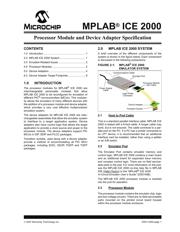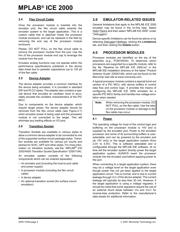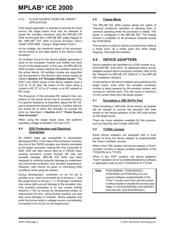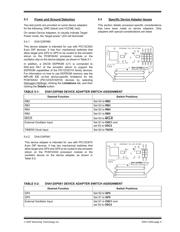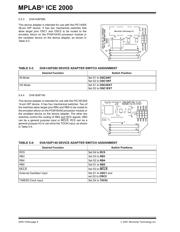Datasheet 搜索 > 微控制器 > Microchip(微芯) > PIC16C57C-20I/P 数据手册 > PIC16C57C-20I/P 产品描述及参数 3/18 页
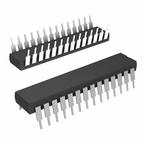
 器件3D模型
器件3D模型¥ 9.485
PIC16C57C-20I/P 产品描述及参数 - Microchip(微芯)
制造商:
Microchip(微芯)
分类:
微控制器
封装:
PDIP-28
描述:
MICROCHIP PIC16C57C-20I/P 微控制器, 8位, PIC16C5xx, 40 MHz, 3 KB, 72 Byte, 28 引脚, DIP
Pictures:
3D模型
符号图
焊盘图
引脚图
产品图
页面导航:
应用领域在P3
导航目录
PIC16C57C-20I/P数据手册
Page:
of 18 Go
若手册格式错乱,请下载阅览PDF原文件

© 2007 Microchip Technology Inc. DS51140N-page 3
4.1.1 EMULATOR PROCESSOR POWER
SUPPLIED BY EMULATOR SYSTEM
If the emulator system is selected to power the emula-
tor processor in the processor module, the emulator
system can be operated without being connected to a
target application. If the system is being connected to a
target application, the power to the pod should be
applied before applying power to the target application.
The target application system’s V
CC will experience a
small current load (10 mA typical) when the emulator
system is connected via a device adapter. This is
because the target system must always power the
clock chip in the processor module.
4.1.2 EMULATOR PROCESSOR POWER
SUPPLIED BY TARGET APPLICATION
SYSTEM
When the MPLAB IDE software is brought up, the
emulator system is first initialized with the emulator
system powering the emulator processor. The
“Processor Power Supplied by Target Board” option
may then be selected using the Power tab of the
Settings dialog (Debugger>Settings
) to power the
processor module from the target board.
When operating from external power, the processor
module will typically represent a current load equivalent
to the device being emulated (according to its data
sheet) plus approximately 100 mA. Keep in mind that
the target application will affect the overall current load
of the processor module, dependent upon the load
placed upon the processor I/O.
When the processor power is supplied by the target
application system, an external clock (from the target
board) may also be provided. MPLAB IDE will not allow
use of an external clock without the use of external
power.
4.1.3 OPERATING VOLTAGE OF 4.6 TO 5.5
VOLTS
If the target application system’s operating voltage is
between 4.55V (±120 mV) and 5.5V, the processor
module will consider this a STANDARD VOLTAGE
condition. In this mode, the processor can run to its
highest rated speed (as indicated in its data sheet).
The recommended power-up sequence is:
1. Apply power to the PC host.
2. Apply power to the emulator pod and processor
module assembly.
3. Invoke MPLAB IDE.
4. Select Debugger > Settings
and click the Power
tab. Configure system for “Processor Power
Supplied by Target Board”.
5. At the error message, apply power to the target
application circuit. Then acknowledge the error.
6. Issue a System Reset (from the debugger
menu) before proceeding.
4.1.4 OPERATING VOLTAGE OF 2.0 TO 4.6
VOLTS
If the target application system’s operating voltage is
between 2.0V and 4.55V (±120 mV), the processor
module will consider this a LOW VOLTAGE condition.
In this mode, the processor is limited to its rated speed
at a given voltage level (as indicated in its data sheet).
To minimize the amount of reverse current that the
target system is exposed to, the recommended
power-up sequence is:
1. Apply power to the PC host.
2. Apply power to the emulator pod and processor
module assembly.
3. Invoke MPLAB IDE.
4. Select Debugger > Settings
and click the Power
tab. Configure system for “Processor Power
Supplied by Target Board”.
5. At the error message, apply power to the target
application circuit. Then acknowledge the error.
6. Issue a System Reset (from the debugger
menu) before proceeding.
7. Select Debugger >
Settings and click the Power
tab. Verify that the dialog says “Low Voltage
Enabled.” Click Cancel to close the dialog.
4.2 Operating Frequency
The processor modules will support the maximum
frequency (except where noted in Section 3.0
“Emulator-Related Issues”) of the device under
emulation. The maximum frequency of a PIC MCU
device is significantly lower when the operating volt-
age is less than 4.5V.
The processor modules will support a minimum
frequency of 32 kHz. When operating at low
frequencies, response to the screen may be slow.
4.3 Clock Options
MPLAB ICE 2000 allows internal and external clocking.
When set to internal, the clock is supplied from the
internal programmable clock, located in the emulator
pod. When set to external, the oscillator on the target
application system will be utilized.
4.3.1 CLOCK SOURCE FROM EMULATOR
Refer to the MPLAB ICE 2000 on-line help file in
MPLAB IDE (Help>Topics
) or the “MPLAB
®
ICE 2000
In-Circuit Emulator User’s Guide” (DS51488), “Using
the On-Board Clock”, for configuring MPLAB IDE to
supply the clock source.
器件 Datasheet 文档搜索
AiEMA 数据库涵盖高达 72,405,303 个元件的数据手册,每天更新 5,000 多个 PDF 文件
